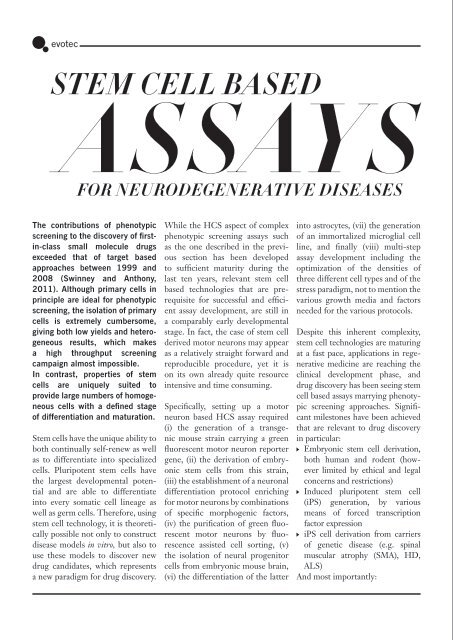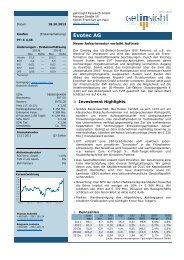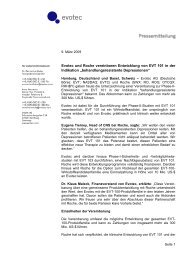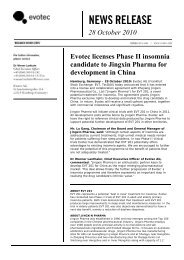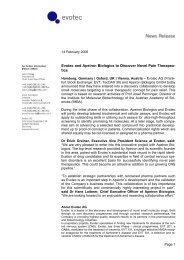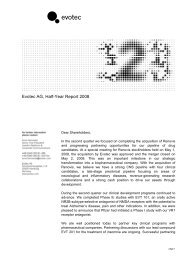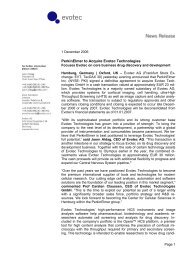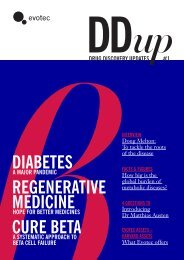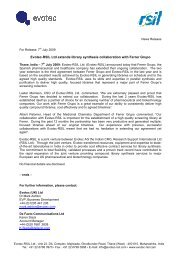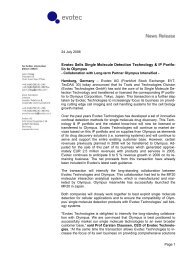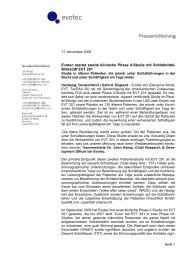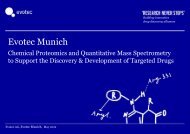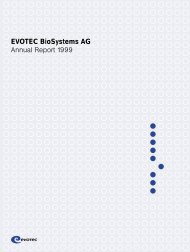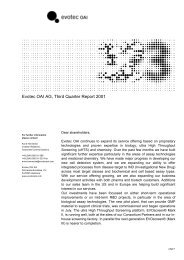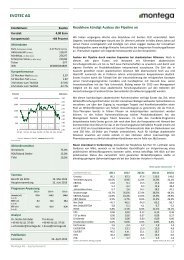Dr anDreas ebnetH - Evotec
Dr anDreas ebnetH - Evotec
Dr anDreas ebnetH - Evotec
Create successful ePaper yourself
Turn your PDF publications into a flip-book with our unique Google optimized e-Paper software.
steM ceLL baseD<br />
assays<br />
foR neuRoDegeneRative Diseases<br />
the contributions of phenotypic<br />
screening to the discovery of firstin-class<br />
small molecule drugs<br />
exceeded that of target based<br />
approaches between 1999 and<br />
2008 (Swinney and anthony,<br />
2011). although primary cells in<br />
principle are ideal for phenotypic<br />
screening, the isolation of primary<br />
cells is extremely cumbersome,<br />
giving both low yields and heterogeneous<br />
results, which makes<br />
a high throughput screening<br />
campaign almost impossible.<br />
in contrast, properties of stem<br />
cells are uniquely suited to<br />
provide large numbers of homogeneous<br />
cells with a defined stage<br />
of differentiation and maturation.<br />
Stem cells have the unique ability to<br />
both continually self-renew as well<br />
as to differentiate into specialized<br />
cells. Pluripotent stem cells have<br />
the largest developmental potential<br />
and are able to differentiate<br />
into every somatic cell lineage as<br />
well as germ cells. Therefore, using<br />
stem cell technology, it is theoretically<br />
possible not only to construct<br />
disease models in vitro, but also to<br />
use these models to discover new<br />
drug candidates, which represents<br />
a new paradigm for drug discovery.<br />
While the HCS aspect of complex<br />
phenotypic screening assays such<br />
as the one described in the previous<br />
section has been developed<br />
to sufficient maturity during the<br />
last ten years, relevant stem cell<br />
based technologies that are prerequisite<br />
for successful and efficient<br />
assay development, are still in<br />
a comparably early developmental<br />
stage. In fact, the case of stem cell<br />
derived motor neurons may appear<br />
as a relatively straight forward and<br />
reproducible procedure, yet it is<br />
on its own already quite resource<br />
intensive and time consuming.<br />
Specifically, setting up a motor<br />
neuron based HCS assay required<br />
(i) the generation of a transgenic<br />
mouse strain carrying a green<br />
fluorescent motor neuron reporter<br />
gene, (ii) the derivation of embryonic<br />
stem cells from this strain,<br />
(iii) the establishment of a neuronal<br />
differentiation protocol enriching<br />
for motor neurons by combinations<br />
of specific morphogenic factors,<br />
(iv) the purification of green fluorescent<br />
motor neurons by fluorescence<br />
assisted cell sorting, (v)<br />
the isolation of neural progenitor<br />
cells from embryonic mouse brain,<br />
(vi) the differentiation of the latter<br />
into astrocytes, (vii) the generation<br />
of an immortalized microglial cell<br />
line, and finally (viii) multi-step<br />
assay development including the<br />
optimization of the densities of<br />
three different cell types and of the<br />
stress paradigm, not to mention the<br />
various growth media and factors<br />
needed for the various protocols.<br />
Despite this inherent complexity,<br />
stem cell technologies are maturing<br />
at a fast pace, applications in regenerative<br />
medicine are reaching the<br />
clinical development phase, and<br />
drug discovery has been seeing stem<br />
cell based assays marrying phenotypic<br />
screening approaches. Significant<br />
milestones have been achieved<br />
that are relevant to drug discovery<br />
in particular:<br />
Embryonic stem cell derivation,<br />
both human and rodent (how -<br />
ever limited by ethical and legal<br />
concerns and restrictions)<br />
Induced pluripotent stem cell<br />
(iPS) generation, by various<br />
means of forced transcription<br />
factor expression<br />
iPS cell derivation from carriers<br />
of genetic disease (e.g. spinal<br />
muscular atrophy (SMA), HD,<br />
ALS)<br />
And most importantly:<br />
Directed differentiation and purification<br />
of specific cell types from<br />
stem cells for drug discovery and<br />
toxicity screening (cardiomyocytes,<br />
hepatocytes, motor neurons,<br />
neural progenitor cells)<br />
Identification of small molecule<br />
compounds directing or enhancing<br />
the differentiation of stem<br />
cells into specific cell types (e.g.<br />
Purmorphamine as Shh mimic,<br />
gamma secretase inhibitors as<br />
neural differentiation enhancer<br />
[Notch pathway blockade], …)<br />
In conclusion, multiple stem cell<br />
based screening scenarios are<br />
becoming applicable to neurodegenerative<br />
diseases.<br />
Phenotypic screening for<br />
compounds that enhance the<br />
generation of a desired specific<br />
Neural Stem cell differentiation pathways high lighting the relevance of<br />
small molecules in stem cell differentiation. Orange arrows depict known<br />
compound-mediated differentiation routes. Modified from Chembl<br />
(http://chembl.blogspot.com/2011/09/stem-cell-differentiation.html)<br />
Neuronal differentiation<br />
Retinal differentiation<br />
Neuroectodermal<br />
differentiation<br />
Glial differentiation<br />
Specific small<br />
molecule effects<br />
Retinal<br />
Precursor Cell<br />
RPE Cell Rod Cell Cone Cell<br />
neural cell type from ES cells,<br />
iPS cells or neural progenitor<br />
cells<br />
Screening for upregulators of<br />
neuroprotective proteins in stem<br />
cell derived neural cells, e.g.<br />
up-regulation of SMN (survival<br />
of motor neuron protein) relevant<br />
to SMA in motor neurons,<br />
or up-regulation of Hsp27 relevant<br />
to neuropathy conditions in<br />
sensory neurons and as general<br />
neuroprotector.<br />
Differential phenotypic screening<br />
with ES or iPS derived<br />
wild-type and mutant neural<br />
cells, e.g. striatal neurons carrying<br />
HD causing polyQ lengths<br />
vs. wildtype control.<br />
Taken together, stem cell derived<br />
neural assays hold great promises<br />
23<br />
for developing multiple neurodegeneration<br />
relevant assay<br />
scenarios, in particular when<br />
combining phenotypic approaches<br />
with modern tools for in formed<br />
segregation of involved pathways.<br />
However, phenotypic screening<br />
is only the first step in the drug<br />
discovery process. Subsequent<br />
elucidation of the molecular<br />
mechanism of effective compounds<br />
is becoming mandatory. <strong>Evotec</strong> is<br />
a leading provider of quantitative<br />
chemoproteomics and the profiling<br />
of targets for pharmacologically<br />
active compounds. This,<br />
together with its expertise in medicinal<br />
chemistry ensures that the<br />
molecular targets of screening hits<br />
can be identified and optimized at<br />
<strong>Evotec</strong>.<br />
Embryonic stem cell<br />
Ectoderm<br />
Neuroectoderm<br />
Neuroblast Glioblast oligodendrocyte<br />
Neuron Precursor Cell<br />
Precursor Cell<br />
Dopaminergic<br />
Neuron<br />
Neural Stem Cell<br />
Motor<br />
Neuron<br />
Astrocyte oligodendrocyte<br />
Striatal Neuron<br />
Hippocampal<br />
Neuron<br />
Sensory Neuron


